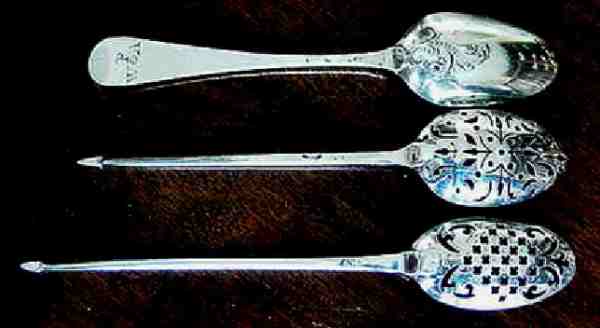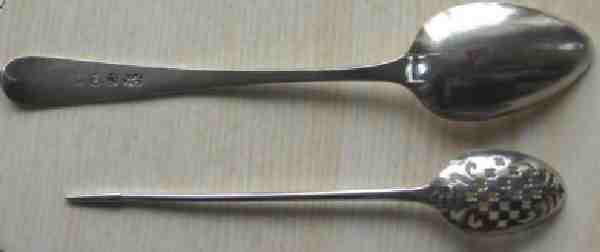by David
McKinley
(click on photos to enlarge image)
MOTE SPOON: A FRAUDULENT CONVERSION
I think that ASCAS readers might be interested to know about
a fraud that is common and appears to go unnoticed by many
experts in auction houses and elsewhere.
It is all too easy to obtain a mid 18th century teaspoon through
the internet or even in a junk shop for about £10.00 or £20.00
and then, for very little effort, turn this investment into
£110.00 or £120.00 by reshaping the handle and piercing a few
holes in the bowl. Thus creating a mote spoon.
The main feature to look for in this particular fraud is "length
and shape". The original name for the mote spoon was ‘Long or
Tea Strainer Spoon’ (the term ‘Mote Spoon’ was coined in the
19th century) and the important word in this description is
‘Long’! Even though mote spoons did get shorter as the 18th
century progressed they did not become as short as teaspoons.
The upper spoon in the illustration is a mid 18th century fancy
back teaspoon and the spoon immediately below it is the same
size and is a fake mote spoon. The lower spoon is a genuine mid
18th century mote spoon and I have chosen the shortest in my
collection to illustrate that even this is noticeably longer
than the fake.
The other features to look out for are the shape of the bowl (
mote spoons usually have longer and narrower bowls than
teaspoons) and the piercing (the common feature in most mote
spoons is that from about 1735 onwards the piercer used
crosslets as well as other fretwork and simple holes are not
common at this date). These are not foolproof features but taken
together with the overall length of the spoon can be a good
guide.

|
(from top to bottom)
Spoon, fake mote spoon, genuine mote spoon
|
It would be misleading if I did not mention that there are
genuine miniature mote spoons of the mid 18th century but these
are, as will be seen in the illustration, appreciably smaller
than teaspoons. These are believed not to be toys (in the modern
sense) but no explanation for them has yet been suggested. In
this connection no substantiated suggestion for the use of the
full sized mote spoon has yet been put forward. It is likely
that they were not for skimming ‘motes’ from the top of the tea
in a cup since, by experiment, the piercing proves to be much
too large for this!

|
teaspoon and small
genuine mote spoon
|
Notwithstanding the foregoing it must be said that there are
occasions when it is very difficult to determine the
authenticity of a mote spoon and, I am afraid, I have no advice
to cover such occasions.
My last illustration is of a ‘fancy front’ mote spoon and this
alone is unusual.
The overall length of this spoon is the same as that of the
genuine mote spoon illustrated above but the marks, the sterling
lion and the maker’s mark, would suggest a mid 18th century date
for its manufacture whilst the piercing is, as stated above,
unusual for such a date. Although the shape of the bowl is more
mote spoon than tea spoon the spike at the finial end of the
stem is unusual to the extent that it may even be unique. The
‘vase of flowers’ decoration in the bowl has been engraved
rather than die struck and this feature is also very unusual.
For all these reasons this spoon was condemned by experts at a
meeting of The Silver Spoon Club whilst the expert at The
Victoria and Albert Museum (V & A) considered it a ‘good’ spoon.
I illustrate and describe this spoon to show how difficult it
can be to determine whether or not such a spoon is genuine when
there is a mixture of ‘good‘ and ‘bad‘ features. However, on the
whole, the guidelines laid out above will serve in most cases.

|
mote spoon of debated
genuineness
|
David McKinley
- 2009 -
David McKinley devotes much of his time to researching
the history of silversmithing in England with particular
reference to hallmarking at the London office. He writes
for both The Silver Spoon Club of Great Britain and The
Silver Society.
|
|
|
 ASSOCIATION OF SMALL COLLECTORS OF ANTIQUE SILVER
ASSOCIATION OF SMALL COLLECTORS OF ANTIQUE SILVER

